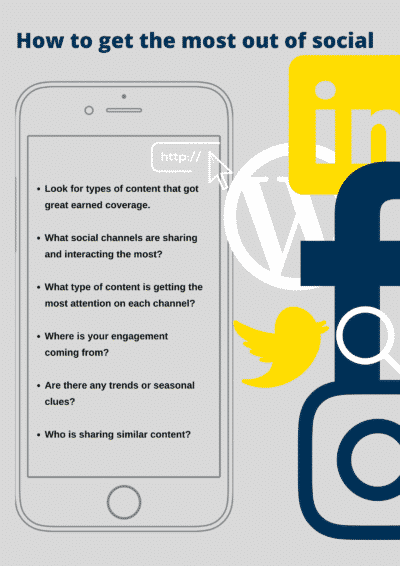Digital PR can be defined in a number of different ways. Some commonalities amongst definitions is that the practice uses strategies from the following other practices: SEO, PR, link building, content marketing, advertising, and journalism. For simplicity’s sake, let’s say:
Digital PR is the creation of content in order to earn high-quality, relevant, inbound backlinks to increase the SEO ranking of a brand, product, or website.
Digital PR is mainly done to earn backlinks from high-authority websites. The thinking goes, more high-quality links equals more ‘link juice’ to the site, to help it rank better on SERPs. But Digital PR can do even more than that. It can positively contribute to other important aspects, such as:
- Brand awareness
- Google Search Quality Evaluator Guidelines like Expertise – Authority – Trust (EAT)
- Personal brand amplification
- Reputation management
We believe that Digital PR should be a long-term strategy; however, Digital PR can also play a major role in supporting other SEO projects. Digital PR can come in handy to give your SEO projects a boost with some fresh backlinks from relevant domains pointing to a new product page, for example.
Here are some things you can do today to kick-start your Digital PR and start working toward those goals you’ve set.
Know the state of your backlinks
Everyone has to start somewhere, and it’s best to know now what you’re facing. You’ve got to know what you’re dealing with, and this will also make measuring results later easier if you can clearly see where you started.
The very first thing you need to do is to pull a backlink report for your domain. There are many tools out there that do this, and most offer a free trial of some sort. You want to pull a report of historical referring domains for the site. Format your spreadsheet to sort the domains by authority, and start looking at the best and worst referring domains in the spreadsheet. Have you noticed any trends? Perhaps your best backlinks are from some top-tier media coverage, or maybe there are high-authority websites pointing to your domain. What types of content seem to earn the biggest backlinks?
Now scroll to the bottom of the list and see what the lower-quality links look like. Are they spammy? Indicators of low-quality links are typically things like links from sites in countries where your brand doesn’t have a market, links with questionable anchor text that don’t relate to your brand, and links to pages or sites that contain numerous backlinks. You may want to consider disavowing them, but remember Google prefers a natural backlink profile, so a perfect-looking bunch of backlinks might look suspicious. You’ll have to decide what is natural for your brand; however, a good rule of thumb is if the backlink is relevant to your brand it’s probably best to keep it.
Identify some quick wins
It’s also a good idea to check for unlinked brand mentions and start an outreach list of sites you’ll contact to ask for a backlink. I wouldn’t be surprised if I was contacted to link to brands mentioned in this article; it’s par for the course in link building land. You can increase your chances of getting your backlink if you spot an error on the page, or can offer an SEO-friendly suggestion for the target brand. Then you can say while you’re there, would you mind linking to our domain? It doesn’t work every time, but it certainly doesn’t hurt to be helpful.
While you’re in the tool and taking advantage of your free trial, pull a report for an aspirational competitor and a direct competitor and have a nose around their backlinks. Are there sites that have linked to them but not to you? Why? Make a target list for those sites that don’t include your brand. Also check what types of content is landing your competitor their coverage. In what areas are they doing better than you? In what areas are you outperforming them? Knowledge is power!
Research the state of your social media
Next up is to research what your content is doing on social media. BuzzSumo will give you some really useful insights and will help tremendously with content research, so sign up for their free trial and pull your report. Here are some things to look for:
- Types of content that got great earned coverage (infographics, reports, memes).
- What social channels are sharing and interacting the most?
- What type of content is getting the most attention on each channel?
- Where is the engagement coming from?
- Are there any trends or seasonal clues?
- Who is sharing similar content? Start a seed list.
Start forming key takeaways
Now you should have a good start on the research needed to inform your content strategy and you can start spotting takeaways like the following:
- Top backlinks for the brand are from high-authority editorial websites featuring factual information about our product/service from FAQ pages.
- The links are mainly do-follow directly to the FAQ page and the most popular shared coverage was on X topic shared over 4,000 times on Facebook.
- The annual report earns backlinks from high-quality editorial websites but they are typically no-follow.
- Our infographics are shared more on LinkedIn than on Twitter.
The same goes for your direct competitors:
- Top backlinks for our direct competition are from industry/niche websites featuring interviews with their CEO about the state of the industry.
- The links are mainly do-follow directly to the home page and the most popular shared coverage was on X topic shared over 100 times on LinkedIn.
You may find even more from your aspirational competitors:
- Top backlinks for our aspirational competition are from a wide range of websites featuring interviews to product recommendations to marketing and PR campaigns.
- The links are mainly do-follow directly to the home page and the most popular shared coverage was on X topic RT’d over 10,000 times on Twitter.
Use your research for your next campaign
All of this information will help you the next time you ideate for your own campaign. Use the research as a starting point when ideating with your team. Once you come up with a few ideas that play to the strengths from your research, it’s good to qualify them once more to make sure you are on the right track.
You can create a qualification checklist specific to your brand with questions such as:

Is it worth linking to?
If you have done the actions above and considered the questions, you’re further ahead on your next campaign than you realise. All of these things can help kickstart your next Digital PR project, and remember, Digital PR is for the long-term, so keep revisiting these points and updating them as the brand – and your backlink profile – changes.




